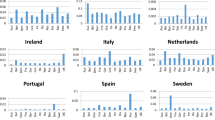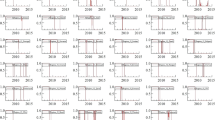Abstract
This paper dissects the dynamic interdependencies between credit default swap spreads among several European Union (EU) countries (Belgium, Bulgaria, Croatia, France, Germany, Greece, Hungary, Italy, Portugal, Romania, Slovakia, and Spain) during the period between October 2004 and July 2016. Its purpose is to delineate interdependence patterns in credit risk in order to identify whether a particular country, such as Greece, or a group of countries, disproportionately transmit credit risk to the remaining sampled EU countries. The findings herein show that the interdependencies between countries’ credit risks are heterogeneous across time. Specifically, when mapping credit risk transmission channels during the 2008–2009 financial crisis and 2011–2013 European debt crisis, respectively, it is evident that transmission patterns shift whereby some countries transmit more credit risk than others. Finally, despite recent news headlines, it cannot be shown empirically that Greece is the dominant transmission catalyst for shocks in the credit risks of the remaining sampled EU countries.







Similar content being viewed by others
Notes
Although the UK voted on a referendum, held on June 23, 2016, to leave the EU, it may take several years for the UK to actually negotiate its exit. According to the Lisbon Treaty, for a country to leave the EU, it must invoke Article 50, which gives the EU and the exiting country 2 years to agree to exit terms. The URL which outlines Article 50 of the Lisbon Treaty can be accessed online: http://www.lisbon-treaty.org/wcm/the-lisbon-treaty/treaty-on-European-union-and-comments/title-6-final-provisions/137-article-50.html. Theresa May, the current prime minister for the UK, has stated she will not initiate this process before the end of 2016. One of the primary concerns now for the UK is to determine what to do with EU citizens who work and reside in the UK but who are not permanent residents: http://www.bbc.com/news/uk-politics-32810887.
Shiller (2000) explains that business news from the media directed to investors has become so pervasive in the US that “...traditional brokerage firms found it necessary to keep CNBC running in the lower corner of their brokers’ computer screens. So many clients would call to ask about something they had just heard on the networks that brokers (who were supposed to be too busy working to watch television!) began to seem behind the chase...” (p. 29).
Not all EU member states are included because some of them have scant or incomplete CDS data. Other countries, as Hui and Chung (2011) mention, have no active sovereign CDS market altogether (Cyprus, Luxembourg, Malta, to name a few).
Information and data (the dummy variables) on the OECD recession indicators for the Euro area can be accessed online: https://fred.stlouisfed.org/series/EUROREC.
Castro et al. (2015) provide an in-depth review and analysis of the PP test along with its advantages and disadvantages, focusing in particular on time-series data which display a strong cyclical component.
Various kernel-based sum-of-covariances estimators and autoregressive spectral density estimators are entertained to check the robustness of the PP test (not tabulated). The choice of using a kernel-based estimator versus a spectral density estimator does not systematically affect the aforementioned findings in any substantive way.
Although GDP per capita is not a theoretically infallible method to determine ‘economic influence,’ for the sake of robustness, when GDP per capita is used as the criteria to establish k ordering of the countries (whereby high average GDP per capita countries are first and then followed by relatively lower average GDP per capita countries), the variance decompositions (not tabulated) are qualitatively analogous to those reported in Tables 9, 10, 11, 12, 13 and 14. This suggests some insensitivity to the results with respect to variable ordering.
Compared with literature that focuses on the dynamic interlinkages in bond markets and interest rates, the impulse response functions in Fig. 4 and 5, b are distinctive in at least two ways; first, they do not necessarily show a significant shock at the first few periods which dies out immediately afterwards (as is the case for the bond markets and interest rates). Second, it is possible that many weeks later, the impulse response function shows signs of life and reveals shifts in its pattern (look at the response of DE to EL in Fig. 4 after week 8, for example). These types of behaviors are not customary in impulse response functions involving bond markets and interest rates. An early study by Mills and Mills (1991, p. 278) concluded that “...these quick reactions to innovations suggest that the behavior of bond markets seem to be broadly consistent with the notion of informationally efficient international financial markets, implying that it would be difficult to earn unusual profits by operating in a particular market based on observed developments in other markets.” The question of whether CDS markets are ‘efficient’ in this sense (compared to fixed income markets) is an interesting question that is left to future research to explore.
References
Acharya, V. V., & Johnson, T. C. (2007). Insider trading in credit derivatives. Journal of Financial Economics, 84, 110–141.
Alter, A., & Schuler, Y. S. (2012). Credit spread interdependencies of European states and banks during the financial crisis. Journal of Banking and Finance, 36, 3444–3468.
Bayoumi, T., & Vitek, F. (2013). Macroeconomic model spillovers and their discontents. IMF working paper no. 13/4 (Washington, DC: International Monetary Fund).
Blanco, R., Brennan, S., & Marsh, I. W. (2005). An empirical analysis of the dynamic relation between investment-grade bonds and credit default swaps. Journal of Finance, 60, 2255–2281.
Boudoukh, J., Feldman, R., Kogan, S., & Richardson, M. (2013). Which news moves stock prices? A textual analysis. NBER working paper no. 18725 (Cambridge, MA).
Castro, T. D. B., Rodrigues, P. M. M., & Taylor, R. A. M. (2015). On the behavior of Phillips–Perron tests in the presence of persistent cycles. Oxford Bulletin of Economics and Statistics, 77, 495–511.
Chan-Lau, J. A., & Kim, Y. S. (2004). Equity prices, credit default swaps, and bond spreads in emerging markets. IMF working paper no. WP/04/27 (Washington, DC).
Chan-Lau, J. A., Mitra, S., & Ong, L. L. (2007). Contagion risk in the international banking system and implications for London as a global financial center. IMF working paper no. WP/07/74 (Washington, DC).
Clark, G. L., Thrift, N., & Tickell, A. (2004). Performing finance: the industry, the media and its image. Review of International Political Economy, 11, 289–310.
Cornett, M. M., Erhemjamts, O., & Musumeci, J. (2016). Were US banks exposed to the Greek debt crisis? Evidence from Greek CDS spreads. Financial Markets, Institutions and Instruments, 25, 75–104.
CNBC (2015a). Asian equities plunge as Greece weighs on sentiment. June 29, 2015.
CNBC (2015b). Traders fear Greece and are watching Yellen. July 9, 2015.
CNBC (2015c). Greece bailout deal optimism boosts sentiment. August 17, 2015.
Da, Z., Engelberg, J., & Gao, P. (2015). The sum of all FEARS: Investor sentiment and asset prices. Review of Financial Studies, 28, 1–32.
Dickey, D. A., & Fuller, W. A. (1979). Distribution of the estimators for autoregressive time series with a unit root. Journal of the American Statistical Association, 74, 427–431.
Dickey, D. A., & Fuller, W. A. (1981). Likelihood ratio statistics for autoregressive time series with a unit root. Econometrica, 49, 1057–1072.
Elliott, G., Rothenberg, T. J., & Stock, J. H. (1996). Efficient tests for an autoregressive unit root. Econometrica, 64, 813–836.
Engle, R. F., & Granger, C. W. J. (1987). Co-integration and error correction: Representation, estimation, and testing. Econometrica, 55, 251–276.
Forbes, K. J., & Rigobon, R. (2001). Measuring contagion: Conceptual and empirical issues. In Stijn Claessens & Kristin J. Forbes (Eds.), International Financial Contagion. Norwell: Kluwer Academic Publishers.
Forte, S., & Pena, J. I. (2009). Credit spreads: An empirical analysis on the informational content of stocks, bonds, and CDS. Journal of Banking and Finance, 33, 2013–2025.
Hall, A. (1994). Testing for a unit root in time series with pretest data-based model selection. Journal of Business and Economic Statistics, 12, 461–470.
Hamilton, J. D. (1994). Time series analysis. Princeton: Princeton University Press.
Hjalmarsson, E., & Osterholm, P. (2010). Testing for cointegration using the Johansen methodology when variables are near-integrated: Size distortions and partial remedies. Empirical Economics, 39, 51–76.
Hui, C.-H., & Chung, T.-K. (2011). Crash risk of the euro in the sovereign debt crisis of 2009–2010. Journal of Banking and Finance, 35, 2945–2955.
Hull, J., Predescu, M., & White, A. (2004). The relationship between credit default swap spreads, bond yields, and credit rating announcements. Journal of Banking and Finance, 28, 2789–2811.
IMF. (2015). Spillover report. Washington, DC: International Monetary Fund.
IMF. (2016). Global financial stability report—Potent policies for a successful normalization. Washington, DC: International Monetary Fund.
Johansen, S. (1991). Estimation and hypothesis testing of cointegration vectors in Gaussian vector autoregressive models. Econometrica, 59, 1551–1580.
Johansen, S. (1995). Likelihood-based inference in cointegrated vector autoregressive models. Oxford: Oxford University Press.
Kenourgios, D. (2014). On financial contagion and implied market volatility. International Review of Financial Analysis, 34, 21–30.
Kenourgios, D., & Dimitriou, D. (2015). Contagion of the global financial crisis and the real economy: A regional analysis. Economic Modelling, 44, 283–293.
Koop, G. H., Pesaran, H., & Potter, S. M. (1996). Impulse response analysis in nonlinear multivariate models. Journal of Econometrics, 74, 119–147.
Litterman, R. B. (1986). Forecasting with Bayesian vector autoregressions: Five years of experience. Journal of Business and Economic Statistics, 4, 25–38.
MacKinnon, J. G. (1996). Numerical distribution functions for unit root and cointegration tests. Journal of Applied Econometrics, 11, 601–618.
Mills, T. C., & Mills, A. G. (1991). The international transmission of bond market movements. Bulletin of Economic Research, 43, 273–281.
Mink, M., & De Haan, J. (2013). Contagion during the Greek sovereign debt crisis. Journal of International Money and Finance, 34, 102–113.
Palladini, G., & Portes, R. (2011). Sovereign CDS and bond pricing dynamics in the euro-area. NBER working paper no. 17586 (Cambridge, MA).
Pan, J., & Singleton, K. J. (2008). Default and recovery implicit in the term structure of sovereign CDS spreads. Journal of Finance, 63, 2345–2383.
Pesaran, H., & Shin, Y. (1998). Generalized impulse response analysis in linear multivariate models. Economics Letters, 58, 17–29.
Phillips, P. C. B., & Perron, P. (1988). Testing for a unit root in time series regression. Biometrika, 75, 335–346.
Shiller, R. (2000). Irrational Exuberance. Princeton: Princeton University Press.
Sicherman, N., Loewenstein, G., Seppi, D. J., & Utkus, S. P. (2016). Financial attention. Review of Financial Studies, 29, 863–897.
Sims, C. A., & Zha, T. (1998). Bayesian methods for dynamic multivariate models. International Economic Review, 39, 949–968.
The Guardian (2016). The Eurozone crisis is back on the boil. February 12, 2016.
Thrift, N. (2001). It’s the romance, not the finance, that makes the business worth pursuing: Disclosing a new market culture. Economy and Society, 30, 412–432.
Wall Street Journal (2015a). Emerging market currencies tumble as worries over Greece, Ukraine escalate. February 12, 2015.
Wall Street Journal (2015b). Greece contagion returns to Eurozone bonds. June 15, 2015.
Wall Street Journal (2015c). Dow tumbles 350 points as Greek crisis worsens. June 29, 2015.
Wall Street Journal (2015d). Investors brace for big moves in wake of Greek vote. July 5, 2015.
Wall Street Journal (2015e). Greek contagion and why it is different this time. July 8, 2015.
Wisniewski, T. P., & Lambe, B. J. (2015). Does economic policy uncertainty drive CDS spreads? International Review of Financial Analysis, 42, 447–458.
Author information
Authors and Affiliations
Corresponding author
Rights and permissions
About this article
Cite this article
Koutmos, D. Interdependencies between CDS spreads in the European Union: Is Greece the black sheep or black swan?. Ann Oper Res 266, 441–498 (2018). https://doi.org/10.1007/s10479-018-2788-0
Published:
Issue Date:
DOI: https://doi.org/10.1007/s10479-018-2788-0




